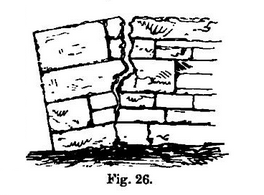revolution, thus (Fig. 26); it nevertheless almost invariably happens that the line of fracture, whether in stonework or brickwork, follows down or along a line of joints, producing a jagged or serrated fissure, the jaws or serrations depending upon the length of bed of each block or brick, and the depth of the courses.

It has been found that the adhesion of Portland cement to Portland stone is only 146 lbs. per square inch, while the cohesion of the cement itself is 400 lbs. per square inch, or the former little more than one-third; and that the adhesion of Parker's cement to granite is as low as 22 lbs. per square inch, the cohesion of the cement being 300 lbs. per square inch, or less than one-thirteenth. The adhesion of common lime mortar varies enormously, with the nature of its materials, the sort of stone or brick which it is used to cement, the thickness of the joints, the care taken to fill them effectually and solidly, the degree of wetness or dryness of the mortar itself and of the stone or brick to which it has been applied, and the rate at which the mortar has been dried during its setting, and the amount of moisture and of air to which it has been subsequently exposed. All these conditions, or some of them, have been found sufficient to make a difference of absolute cohesion of more than 2 : 1 between old Roman mortar consolidated and hardened for ages, and good modern mortar allowed sufficient time to be viewed as fully set or indurated. When very dry, mortar. is much more brittle and easily fractured than when wet even after complete induration
